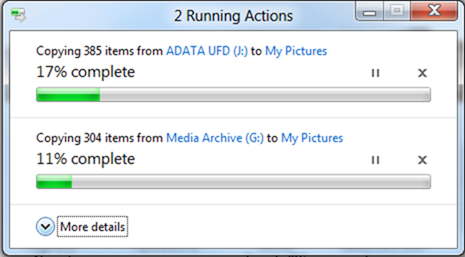Microsoft improves file management in Windows 8

Microsoft has showed off some of the changes it has made to the file copying, moving, renaming and deleting user interface in Windows 8 on the Building Windows 8 blog.
Microsoft had three goals in mind:
- One place to manage all copy jobs: Create one unified experience for managing and monitoring ongoing copy operations.
- Clear and concise: Remove distractions and give people the key information they need.
- User in control: Put people in control of their copy operations.
So, what do we have that's different? Well, first off we have a single dialog box for multiple file operations rather than having Windows spawn multiple dialog box. From this box users will be able to pause, resume and stop transfers, as well as have the option to see more details such as data transfer speeds.
Cosmetic changes, but much-needed nonetheless.
Microsoft has also improved the handling of 'file name collisions' when copying a file to a location where a file with the same name already exists. A simple dialog with checkbox options replaces the current confusing hellstew of options.
In addition, Microsoft has also removed a lot of of the redundant confirmation dialogs such as the 'are you sure you want to move this file to the recycle bin?' or 'are you sure you want to merge these folders?'
Nice changes that will certainly streamline file operations. However, this doesn't address my biggest issue with file operations, which is the continued heavy reliance on file names. Why is the filename still the metric used to determine whether files are identical or not? Why not something more unique? Something like a checksum? This way the operating system could decide is two files really are identical or not, and replace the file if it's a copy, or create a copy if they are different. This would save time, and dramatically reduce the likelihood of data loss through overwriting.
What do you think of these tweaks?
